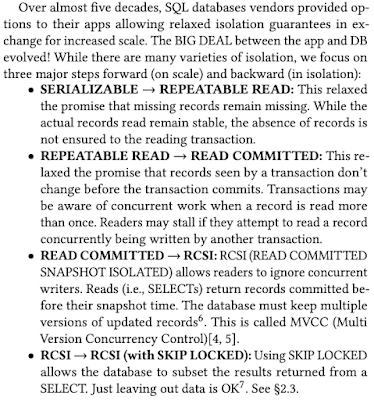Concurrency Control and Recovery in Database Systems: Preface and Chapter 1
I'm catching up on Phil Eaton's book club and just finished the preface and Chapter 1 of Concurrency Control and Recovery in Database Systems by Bernstein, Hadzilacos, and Goodman.
This book came out in 1987: two years before the fall of Berlin wall, 5 years before Windows 3.1, and before the Gray/Reuters book on Transaction Processing.
I was first surprised about why "Recovery" was featured prominently in the book title, but then realized that in 1987 there was no solid solution for recovery. The ARIES paper on the write-ahead-log came out in 1992.
Once I realized that, the structure made sense: concurrency control (Chapters 1–5), recovery (Chapters 6–7), and a forward-looking chapter on replication (Chapter 8), where they candidly admit: "No database systems that we know of support general purpose access to replicated distributed data."
- The Problem
- Serializability Theory
- Two Phase Locking
- Non-Locking Schedulers
- Multiversion Concurrency Control
- Centralized Recovery
- Distributed Recovery
- Replicated Data
Chapter 1: The Problem
Chapter 1 motivates the twin problems of concurrency control and recovery. It defines correct transaction behavior from the user’s point of view and introduces an internal system model that will be used throughout the book.
"User's point of view" here means an operational one, focused on histories of reads/writesm rather than the state-based, client-centric view I am fond of. (See my write-up of Seeing is Believing, Crooks et al., PODC 2017.)
With 40 years of hindsight, the definitions in Chapter 1 reads as straightforward: transactions, commit/abort, recoverability, cascading aborts, lost updates, serializability. The chapter uses many scenarios to illustrate how transactions interfere and how their effects must sometimes be undone upon abort.
I was initially surprised by the level of detail around undoing writes, until I remembered that this is a single-version model. No MVCC yet. Chapter 5 eventually gets there, explaining its benefits and trade-offs. But in 1987, MVCC was too costly in terms of storage/CPU, and OCC was not considered due to high contention workloads of that era. Instead, transactions were implemented with 2PL on resource-constrained single computers. Bernstein himself contributed a lot for the popularization of both MVCC and OCC.
The chapter closes with a model of a database system with four components: transaction manager (TM), scheduler, recovery manager (RM), and cache manager (CM). Transactions issue operations to the TM, which forwards them to the scheduler for concurrency control. The scheduler ensures serializability (and often strictness) by delaying, executing, or rejecting operations. The RM guarantees atomicity and durability, and uses Fetch/Flush from the CM to read/write persistent state. The CM handles movement between volatile and stable storage.
Coordination among modules relies on handshaking: if a module wants two operations ordered (say, write before flush), it must wait for an acknowledgment before issuing the next operation. This is a minimalist model of layered interaction that earns points for clarity and separation of concerns, although real systems today bear little resemblance to it.






Comments